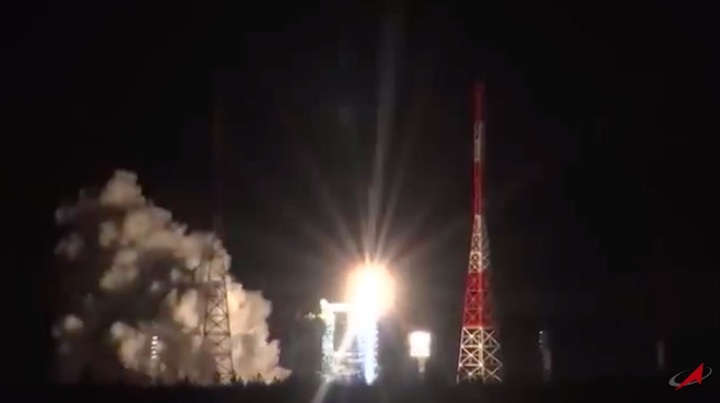4.05.2022

Russia fired a rocket into orbit Friday from the Plesetsk Cosmodrome in the first use of an Angara launcher for a satellite mission, 30 years after starting work on the program just after the collapse of the Soviet Union.
The payload carried by the Angara 1.2 rocket was a classified Russian military satellite. U.S. tracking data showed the payload deployed in a polar orbit ranging between 173 miles and 182 miles (279 by 294 kilometers).
The mission began with liftoff from the Site 35 launch complex at 1955 GMT (3:55 p.m. EDT) Friday 29.04.2022. The 137-foot-tall (42-meter) Angara 1.2 launcher tilted its RD-191 main engine to steer on a trajectory north from Plesetsk, a military spaceport located about 500 miles (800 kilometers) north of Moscow.
Liftoff occurred at 10:55 p.m. Moscow time, just after sunset at the Plesetsk Cosmodrome. The Russian Aerospace Forces, a division of the Russian military, managed the launch operations at Plesetsk.
Russian ground crews emblazoned the letter “Z” on the Angara rocket’s payload fairing. Displays of the letter are commonly associated with support for the Russia’s military attack on Ukraine, and many Russian military vehicles participating in the invasion also carry the insignia.
The kerosene-fueled RD-191 engine throttled up to produce 430,000 pounds of thrust and fired for three-and-a-half minutes. Then the expendable booster stage jettisoned to fall back to the ground, and the second stage ignited its RD-0124 engine, derived from a powerplant flown on Russia’s Soyuz upper stage.
A restartable service module engine, or third stage, fired next to place the Russian military satellite at the proper altitude, speed, and inclination for deployment . The Russian Ministry of Defense declared the launch a success, and U.S. military tracking data confirmed the rocket placed its payload into orbit.
The launch marked the first orbital flight of an Angara 1.2 rocket, a light-class launcher designed to haul Russian military and civilian satellites to space. The Angara rocket family also includes the Angara A5 configuration, a heavy-lifter that combines five Angara first stage booster cores.
Russia has launched three test flights of the Angara A5 rocket, each carrying non-functioning payloads to simulate the mass of a satellite. A suborbital version of the Angara 1.2 rocket launched in 2014 on a demonstration flight.
The launch Friday was the first time an Angara rocket deployed a real satellite into orbit. Russian officials released no details about the payload, which was named Kosmos 2555 in the Russian Defense Ministry’s naming scheme for military satellites.
The altitude and inclination of the orbit of Kosmos 2555 led satellite watchers to speculate it might be the next in a line of small Russian military reconnaissance spacecraft, known as EMKA. Russia launched the first two EMKA satellites in 2018 and 2021.
The Angara 1.2 rocket, developed by prime contractor Khrunichev, can place a payload of more than three metric tons (6,600 pounds) into a low-altitude orbit. The Angara A5 can haul up to 24.5 metric tons (54,000 pounds) into a low orbit, or 5.4 metric tons (11,900 pounds) into a higher-altitude geostationary transfer orbit.
The Russian government gave the green light for development of the Angara rocket in 1992. After Khrunichev won the contract to design and build Angara, the Russian government stated the rocket should begin operations by 2005. But funding difficulties repeatedly delayed the Angara program. Finally, in 2014, Russia performed the first two Angara test flights.
At that time, Russian officials said multiple Angara test flights were scheduled before the rocket was to become operational in 2020.
Russia did not meet that schedule. Since 2014, officials have opened a new Angara production facility in Omsk, Russia.
The Angara burns cleaner fuel than the Proton rocket it will replace, which consumes toxic hydrazine and nitrogen tetroxide propellants.
Russian workers are building a new Angara launch pad at the Vostochny Cosmodrome in Russia’s Far East. Russia’s medium-lift Soyuz rocket has launched from Vostochny, Russia’s newest spaceport, since 2016.
Once operational, the Angara rocket will allow Russia to move some of its space launches from the Baikonur Cosmodrome, which the Russian government leases from Kazakhstan, to spaceports on Russian territory.
But Russia’s aspirations to launch commercial satellites on Angara rockets have evaporated in recent months. An embargo on commercial launch business on Russian rockets after Russia’s invasion of Ukraine has forced commercial satellite owners to re-book their missions with other launch providers.
South Korea’s Kompsat 6 radar remote sensing satellite was contracted to launch on an Angara 1.2 rocket, but that deal is now uncertain.
Quelle: SN
